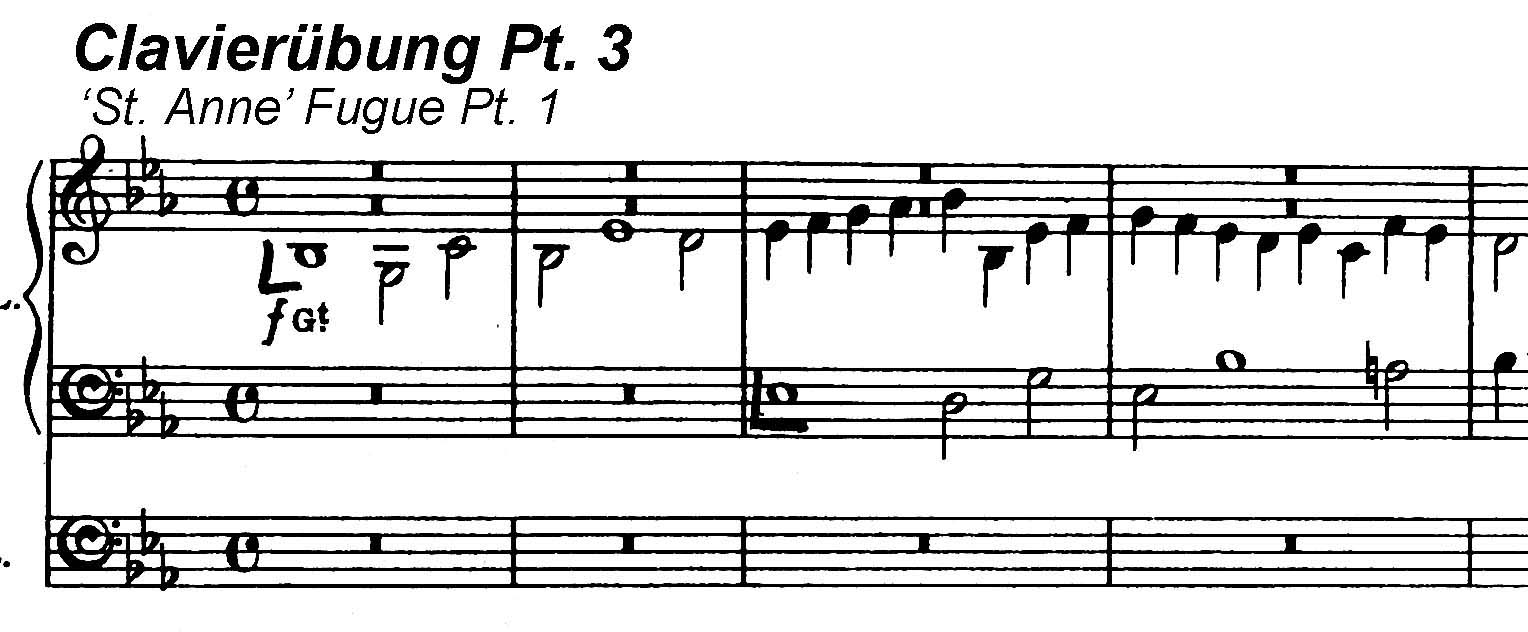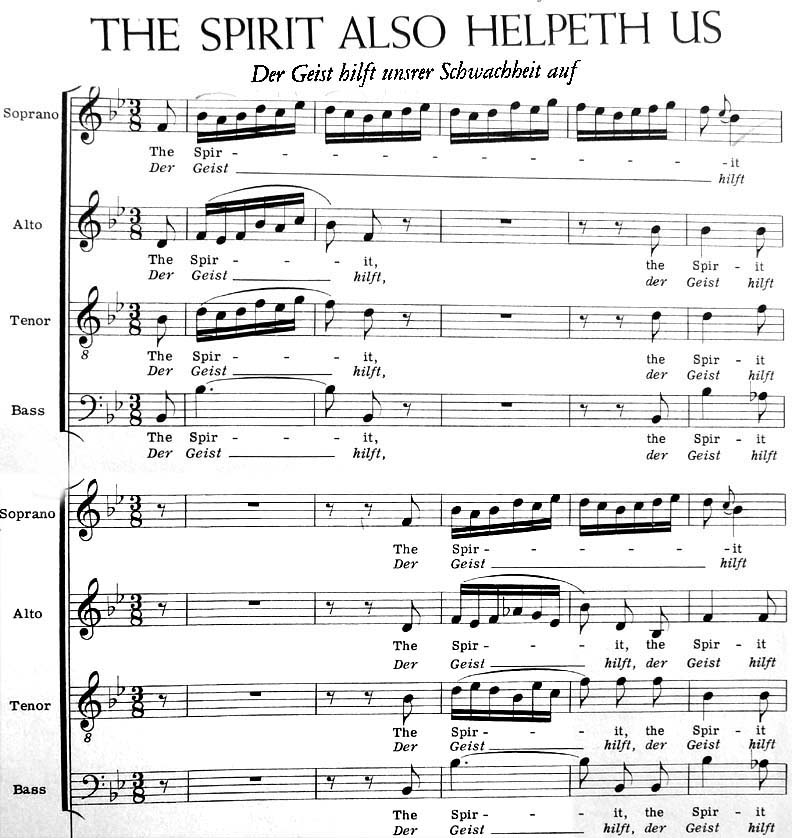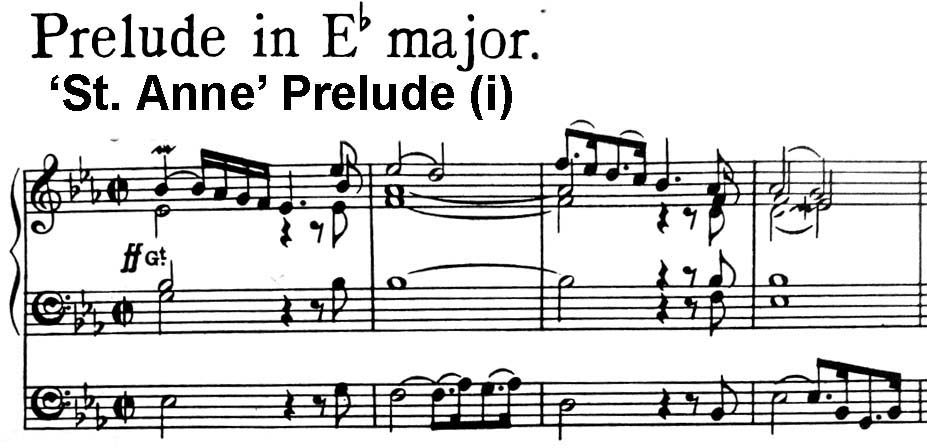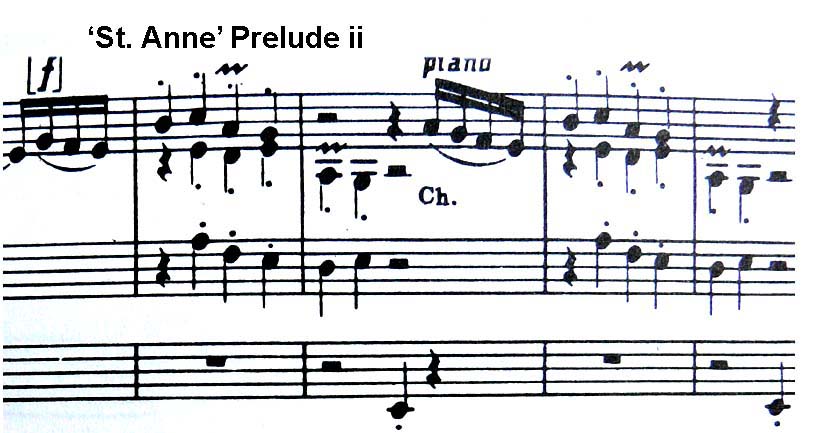WAS BACH A MATH3MAT1C1AN?
by John Bertalot from lectures he gave in
King's College, Cambridge, August 1986
Southwell Minster, July 2000
The Hereford Three Choirs' Festival, August 2003
and Blackburn, September 2010
2. The Prelude and Fugue in E flat major (BWV 552)
from the Clavierubung part 3 (Keyboard Practice) -
and a few Motets.
The Clavierubung consists of 27 pieces of organ music, starting with a grand Prelude in Eb major, and ending with an equally grand Fugue in the same key (BWV 552).
(The number 27 is significant - see below, and also in my next article.)
The Clavierubung was published in 1739, and, apart for the Prelude and Fugue, and also four canons (which are not usually included in published editions), it consists of a set of Chorale Preludes on teachings of the Church:
There are chorale preludes based on the Kyrie,
the Ten Commandments,
the Creed,
the Lord's Prayer,
Baptism,
Penitence and
Communion,
so it is in the form of an Organ Mass.
The name St. Anne was not given by Bach, but because the theme of the first fugue is almost identical to an English hymn tune called St. Anne by the English composer William Croft (1678-1727), which is sung to the words, O God, our help in ages past.
Croft was a pupil of John Blow and became organist of St. Anne's Church, Soho in 1707 thus the name of his hymn tune. Croft is also known for his Burial Sentences, composed for the funeral of Queen Anne in 1714 when he was organist of Westminster Abbey.
Bach's St. Anne fugue is clearly written in praise of the Trinity:
It's in three seemingly independent sections, each with its own fugue subject:
The subject of the first fugue is majestic which could represent God the Father:

(ii) The subject of the second fugue is much lighter, for manuals only, which could represent God the Son:

(iii) The third subject is made up, largely, of semiquavers which could represent the rushing of God the Holy Spirit:

Semiquavers were often used by Bach when he composed music concerning the Holy Spirit, for they could represent the rushing mighty wind of the Spirit who was given at Pentecost (Acts 2: 2)
Look at Bachs motet: Der Geist hilft (The Spirit also helpeth us):

Bach clearly represents the 'rushing of the Holy Spirit' by his use of semiquavers.
But what else can we find here?
1. The first section of this Motet is exactly 123 bars long.
What a lovely number for the Holy Spirit! (But see more about the significance of this number in my next article!)
2. Also, this motet is in 3 time. Also, the full title has 33 letters.

And whilst we're glancing at some of Bach s motets, look at Singet dem Herrn: (Sing to the Lord)
The first movement is in the form of a Prelude and Fugue, with the fugue starting in bar 75.
;This section is 150 bars long! Was this an accident?
No! Look at his motet Furchte dich nicht: (Be not afraid)
Again, the first movement is in the form of a Prelude and Fugue of 154 bars, with the fugue also starting exactly halfway at bar 77.
The number 154 also has mathematical significance... see my next article.
In other words, Bach seems to have had the abiity to compose music with a pre-determined number of bars.
Bach clearly enjoyed introducing mathematical precision into his music. It isn't a coincidence!
But what binds these three seemingly disparate fugues together is the appearance of the original 7-note subject in the other two fugues, but with the rhythm changed:
Fugue 2, 2nd Subject:

Fugue 3, 2nd Subject:

The final pedal entry at the end of the third fugue is one of the most dramatic moments in all organ literature.
But look at the first subject again made up of 7 notes. This is significant, bearing in mind Bach's fascination with numbers (see my first article).
7
The number 7 has great significance in the Bible:
God rested on the 7th day and hallowed it. (Genesis 2:2)
Seven pairs of clean animals went into Noah s Ark (Genesis 7:2)
The seven demons that came out of Mary Magdalene. (Luke 8,2)
Christians should forgive others 70 times 7. (Matthew 18.22)
The seven last words of Jesus on the cross and there are many more examples of the number 7 in the Bible.
The book of Revelation is full of the number 7:
Seven Spirits (1:4)
Seven churches (1:11)
Seven stars and golden candlesticks (1:20)
Seven lamps of fire (4:5)
Seven seals (8:1),
Seven trumpets (8,6)
Seven thunders (10,3)
and there are many more sevens in this book.
3
And, of course, 3 is also a significant number in Christianity for it represents the Trinity.
How did Bach use the number 3 in the fugue?
The key signature of the Prelude and the Fugue is three flats,
The number of bars in each fugue is divisible by 3: 36, 45, 36. Total 117.
One of the joys of numbers is that we can play around with them:
The factors of 117 are 13x3x3 which could represent the Unity of the Trinity:
And taking the above numbers separately and adding them up:
3+6+4+5+3+6 = 27. And 27 equals 3x3x3 which is yet another Trinitarian structure.
The final pedal entry of this fugue is one of the most dramatic moments in all organ literature.
Listen to the end of the fugue, when Bach starts the final entries of the 'Holy Spirit' subject high up, and then he rapidly brings in more entries, all the while descending (as the Holy Spirit descended upon the first disciples at Pentecost) and then, the crowning glory, full pedal with 32ft reed. Wow!
![]()
Now what about the 'St Anne' Prelude which is the first piece in the Orgelbuchlein. Apart from being written in the same key, is there any connection with the 'St Anne' Fugue at the end of this collection?
Yes! This Prelude also has three subjects, each of which could represent, in turn, the three persons of the Trinity.
1 God the Father (majestic)

2 God the Son (more intimate)

3 God the Holy Spirit (with semiquavers)
But is there more?
Yes - this Prelude is 205 bars in length.
What is the significance of that?
Does it have any connection with the other so-called significant numbers mentioned in this article - such as
the 123 bars of Der Geist hilft
the 154 bars of Furchte dich nicht?
See my next article!